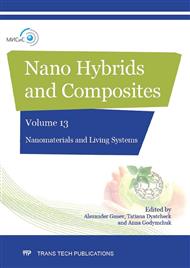[1]
J.O. Nriago, A silent epidemic of metal poisoning, Pollut. Res. 50 (1988) 139-161.
Google Scholar
[2]
Н. Moloukhia, W.S. Hegazy, Е.А. Abdel-Galil, S.S. Mahrous, Removal of Eu3+, Ce3+, Sr2+, and Cs+ ions from radioactive waste solutions by modified activated carbon prepared from coconut shells, J. Chem. Ecol. 32 (2016) 324-345.
DOI: 10.1080/02757540.2016.1139089
Google Scholar
[3]
T. Fakin, A. Ristić, V. Mavrodinova, N.Z. Logar, Highly crystalline binderfree ZSM-5 granules preparation, J. Micropor. Mesopor. Mat. 213 (2015) 108-117.
DOI: 10.1016/j.micromeso.2015.04.010
Google Scholar
[4]
Y. Cho, S. Kim, Н. Park, S. Komarneni, Y. Hong, Removal of inorganic pollutants in rainwater by a peat-derived porous material, J. Porous Mater. 21 (2014) 387-394.
DOI: 10.1007/s10934-014-9784-9
Google Scholar
[5]
F. Sabermahani, M. Saeid,V. Sharifzade, Removal of nickel(II) and palladium(II) from surface waters, B. Chem. Soc. Ethiopia. 27 (2013) 21-28.
DOI: 10.4314/bcse.v27i1.2
Google Scholar
[6]
С. Bertagnolli, А. Grishin, Т. Vincent, Е. Guibal, Recovering Heavy Metal Ions from Complex Solutions Using Polyethylenimine Derivatives Encapsulated in Alginate Matrix, Ind. Eng. Chem. Res. 55 (2016) 2461–2470.
DOI: 10.1021/acs.iecr.5b04683
Google Scholar
[7]
Н. Sehaqui, U.P. de Larraya, Р. Liu, N. Pfenninger, А.Р. Mathew, Т. Zimmermann, Р. Tingaut, Enhancing adsorption of heavy metal ions onto biobased nanofibers from waste pulp residues for application in wastewater treatment, Cellulose. 21 (2014).
DOI: 10.1007/s10570-014-0310-7
Google Scholar
[8]
G. Tan, W. Sun, Y. Xu, H. Wang, N. Xu, Sorption of mercury (II) and atrazine by biochar, modified biochars and biochar based activated carbon in aqueous solution, J. Bior. Tech. 211 (2016) 727-735.
DOI: 10.1016/j.biortech.2016.03.147
Google Scholar
[9]
L. Luo, S. Zhang, Integrated investigations on the adsorption mechanisms of fulvic and humic acids on three clay minerals, Colloids Surf. 406 (2012) 84-90.
DOI: 10.1016/j.colsurfa.2012.05.003
Google Scholar
[10]
L. I. Bel'chinskaya, V. Yu. Khokhlov, T. Y. Lu, G. A. Petukhova, O. V. Voishcheva, A. V. Zhabin, The Influence of Alkaline Treatment on the Chemical Composition and Adsorption–Structural Characteristics of Mineral Nanoporous Sorbent M45K20, Prot. Met. Phys. Chem. + 48 (2012).
DOI: 10.1134/s2070205112030033
Google Scholar


